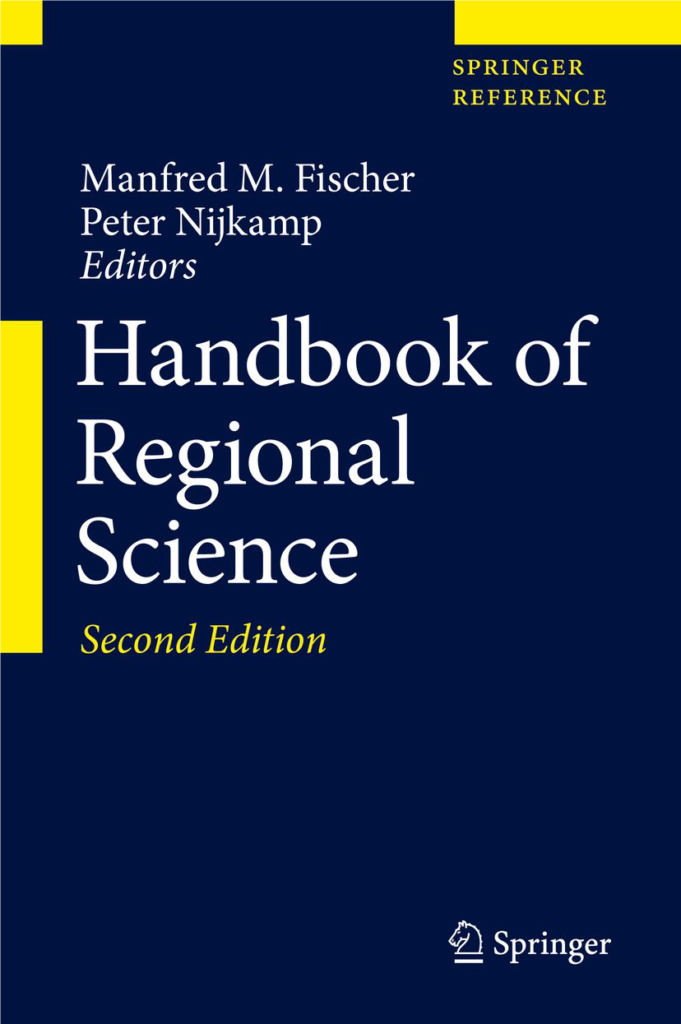
Interview with Manfred Fischer and Peter Nijkamp who have recently published the second edition of the Handbook of Regional Science.
Prologue
Regional science has turned into a respected multi-disciplinary approach to the understanding of complex spatial phenomena and processes in an open society. Its history dates back to the 1950s already, and it is nowadays a mature science with thousands of representatives all over the world. It has over the past decades shown both a broadening and deepening of its scope characterized by novel methodological, theoretical and applied research orientations. In light of the wealth and diversity in regional science studies, there is a need for a comprehensive stock-taking of the current state-of-the-art in regional science.
Why a Handbook of Regional Science?
Manfred Fischer: “According to our experience, there is a need for a comprehensive stock-taking of the current state-of-the-art in regional science. This has inspired us to compose an ambitious Handbook of Regional Science and to invite renowned scientists in the field for a scholarly contribution. “
Peter Nijkamp: “The multi-volume work addresses theory, methodology, application and policy in one opus and is specifically intended to function as an instructional guide for students and established scholars in regional science for ease of use and regular literature access when needed”
“The level of each chapter in the Handbook is such that not only a graduate student or a post-doc researcher, but also a more advanced regional scientist can benefit from a scholarly contribution that does not belong to his or her area of expertise. Each contribution is also a stand-alone entity that covers a particular topic without assuming that the reader will need to read another part of the same topic elsewhere in the Handbook. “
What are the main topics of this handbook?
Manfred Fischer: “The material in this Handbook has been chosen to provide a systematic state-of-the-art presentation of the diversity of current and emergent research topics, theories and models, methods and techniques in regional science, not available elsewhere. The international group of authors was selected for their knowledge of a subject area, and their ability to communicate basic information in their subject area to a world-wide audience succinctly and accessibly.
The reference work contains now 110 chapters and is subdivided into eleven sections that range from the history of regional science over regional housing and labour markets to spatial analysis and geocomputation, and finally to spatial statistics as well as spatial econometrics. “
What are the main changes and innovations in this second edition, compared to the previous one?
Peter Nijkamp: “The second edition of the Handbook of Regional Science has changed considerably since the first edition in 2012, which is most evident by the addition of two new sections, one on the history of regional science and one on regional policy. Most chapters have been updated to incorporate new developments, while others have been rewritten by different authors with fresh perspectives on the material concerned.
Manfred M. Fischer: “There are approximately 30 new chapters written by leading scholars in the field covering topics such as knowledge spillovers, R&D collaboration networks, regional policy assessments, big data issues, dynamic modelling approaches, web-based tools for exploratory spatial data analysis, fuzzy modelling, multivariate spatial process models, endogeneity in spatial models and heterogeneous spatial autoregressive models, amongst others. These additions reflect largely developments that have come to the fore or gained importance since the first edition. It is clear from the amendments and additions in this Handbook that regional science is always ‘work in progress’.”

HANDBOOK OF REGIONAL SCIENCE
Second edition
Edited by
Manfred M. Fischer, Vienna University of Economics and Business, Austria
Peter Nijkamp, Adam Mickiewicz University, Poland
Springer, Berlin, Heidelberg 2020
More from the publisher

Manfred M. Fischer is an Emeritus Professor of Economic Geography at the Vienna University of Economics and Business, and an Adjunct Professor at the Chinese Academy of Sciences. In recognition of his scholarly achievements, he has been named a fellow of the Regional Science Association International, the Royal Dutch Academy of Sciences, the Austrian Academy of Sciences, and the International Academy of Sciences for Europe and Asia. Moreover, he has received the highest accolades from the RSAI: the Jean Paelinck Award for outstanding scholarly achievements in the field of Regional Science Methods (2015), and the Founder’s Medal, which is awarded every four years for significant lifetime contributions (2016).

Peter Nijkamp is an Emeritus Professor of Regional and Urban Economics and Economic Geography at the VU University, and is affiliated with the Jheronimus Academy of Data Science (JADS), ‘s-Hertogenbosch (the Netherlands), the Royal Institute of Technology (KTH), Stockholm (Sweden) and A. Mickiewicz University, Poznan (Poland). He serves on the editorial/advisory boards of more than 30 journals. According to the RePec list he is one of the top 30 most well known economists in the world. His main research interests cover quantitative plan evaluation, regional and urban modelling, multicriteria analysis, transport systems analysis, mathematical systems modelling, technological innovation, entrepreneurship, environmental and resource management, and sustainable development. In all these fields he has published many books and numerous articles.

Stay updated on ERSA upcoming activities, subscribe to ERSA E-newsletter
